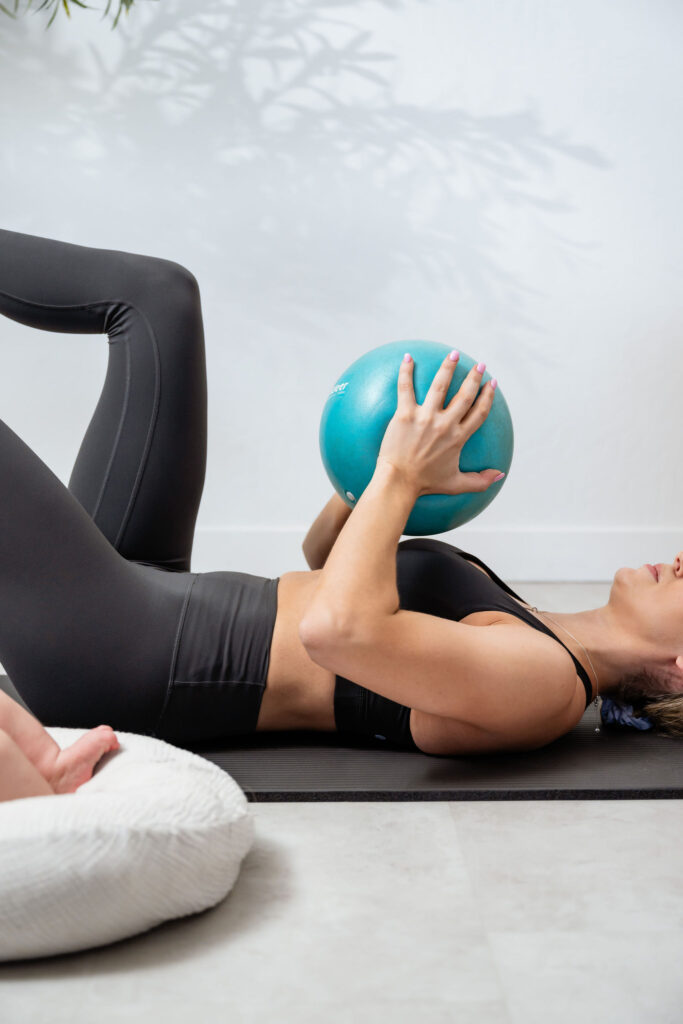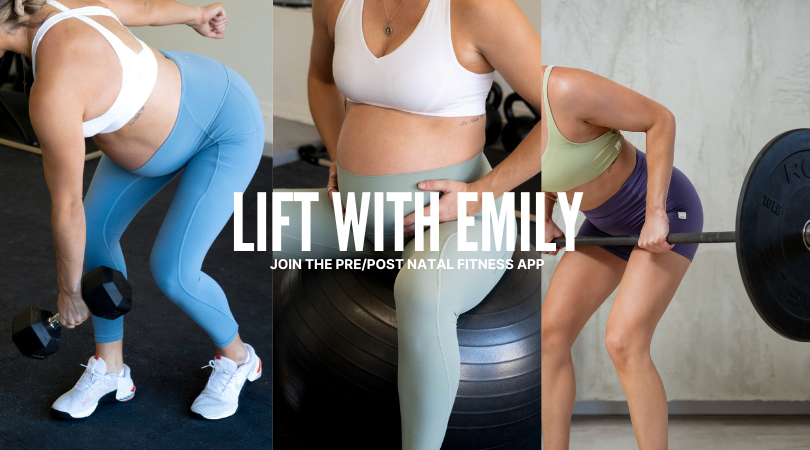
“You’re cleared for exercise” – now what?
Although you may have been given the all clear from your provider, this does not mean you are ready for any and all exercise. Rest alone is not enough and this 6 week ‘all clear’ we are given by our provider is misleading. There is no emphasis or road map on a gradual return to exercise which leaves many moms confused and disappointed that they still don’t feel like themselves at the 6 week mark. Instead, a realistic timeframe for recovering postpartum is 6-18 months.
You can also ‘exercise’ before the 6 week mark. And in fact, I encourage it regardless of a vaginal and cesarean birth. However, ‘exercise’ in that period should not look like anything you were doing pre or during pregnancy and instead support a gentle, intentional movement that focus’ on breathwork, reconnecting to your deep core/body and mobility to support comfort and your daily life.
HOW TO RETURN TO EXERCISE
Regardless of when you start to move your body whether it is before or after that 6 week mark, how do you know what you are ready for?
Healing is not liner. Every rep, every workout that you do is an assessment of your readiness and feedback for where your body is at. There is no such thing as a list of ‘diastasis safe’ or ‘prolapse safe’ exercises or a timeline of where you should be by X weeks postpartum as we walk the line of progression individually.
What our bodies can tolerate depends on multitude of factors. Mom life is tough and your readiness for exercise is ever changing in this phase. We have to consider things happening outside of the gym like; nursing, the amount of sleep you got the night before, adequate nutrition, the amount of stress you’re under and your mental health. It can also be really hard to find consistency in your training which in turn might slow down the process of feeling like yourself in the gym and add to some frustration or disappointment.
FACTORS TO CONSIDER IN YOUR READINESS
SLEEP
How much sleep you are getting plays a huge part of those early weeks and months. Exercise will always be there. Getting in a workout will always be there. And obviously I’m an advocate for for making training and exercise a part of daily life if possible, but there’s also times where rest is going to be far more beneficial than any workout ever could be. Can your body realistically tolerate the stress of 4 workouts a week or are 2-3 20 minute workouts more beneficial and effective for you in this current season?
BLEEDING
If earlier postpartum – prior to your 6 weeks clearance – are you still bleeding? You can begin some light movement if you are but watching for signs of increased bleeding is a good indication you might be doing too much too soon. And yes, even gentle core and pelvic floor contractions can still increase this especially in the first 2 weeks. If you’re noting an increase. Give yourself a few days before progressing.
MENTAL/EMOTIONAL
How was your birth experience? You may be ready for movement earlier after an uncomplicated vaginal birth vs an emergency c section. Regardless of how you gave birth, it can be traumatic for some or you may be mourning the expectation of birth. Your mental and emotional healing is also something to consider.
PELVIC FLOOR SYMPTOMS
What are you symptoms? Are you noticing them improving with movement or worsening? Do you even know the signs to look out for? Even if symptom free, an awareness of potential symptoms is so important because these can begin to show up once you start loading your body more. It’s also key to note here that the presence of symptoms does not mean you should not exercise either – infact – they will likely improve the stronger you get. Navigating dysfunction can be overwhelming, confusing and uncomfortable. I recommend seeking help from a Pelvic Floor Physical Therapist who can put together a structured rehab plan built around individual to your needs.
SYMPTOMS TO PAY ATTENTION:
- Visible signs like coning or doming that cannot be corrected by adjusting your breathing strategy, changing position, increasing support or modifying the movement. Although this is not necessarily bad thing, what it is telling us is that it may be a sign that the exercise is beyond your current capacity.
- Are you struggling to get through all the reps without breath holding or straining and bearing down?
- Do you feel discomfort along your abdominal wall? Or does the exercise hurt to perform.
- Are you leaking with impact or stress?
- Are you feeling pressure or a heavy sensation in your pelvic floor?
- Are you noticing Any pelvic or SI joint pain. Hip pain, low back pain, tailbone pain when performing certain movements or immediately after?
HOW TO INTRODUCE MOVEMENT
360 Diaphragm Breathing
Learning to breathe correctly is one of the most important things you can do for your core and pelvic health during pregnancy and into postpartum. It’s a powerful tool to stabilize and support your body during movement, manage intra-abdominal pressure and keep your body strong.
During pregnancy as your baby grows, it pushes up on the diaphragm and forward on to the abdominals to allow for more space. This can cause the rib cage to be in a constant state on inhalation (expansion) and affect how well the diaphragm can contract and relax. The intercostals (muscles in between your ribs) also become tight and weak from a lack of mobility. A center of gravity shift moves the pelvis into a more anterior tilt. This moves the rib cage slightly backwards and can limit that range of motion further.
All of these physical changes to accomodate your baby adjust the biomechanics of breathing and once are postpartum you will need to relearn how to perform a proper diaphragm breath.
An optimal breath looks like this:
On inhalation, the lungs fill
The diaphragm descends
The rib cage expands to the front, sides and back
The pelvic floor descends
As you exhale, the lungs empty
The diaphragm rises
The rib cage moves down and in
The pelvic floor rises
You can start this as early as your first week postpartum.
ENGAGE LOWER ABDOMINALS
Prior to loading your body with weights in the gym, you want to spend time and attention to re learning a solid core contraction and gradually strengthening (in different positions). What you core can tolerate, how well you manage intra-abdominal pressure and when will be dependent on position, movement, load/resistance, speed and reps and again is something you will want to reassess – and continue to assess – as you progress with your return to exercise.
I love a Hooklying March (shown below) as a good re entry point to a core contraction. Early postpartum deep core exercises are focused on rewiring the brain with breath and movement then gradually progressing over time. We’re reconnecting and strengthening the muscles that have been stretched and lengthened throughout pregnancy. It can be hard to activate your lower abdominals after they’ve been in a lengthened state and sometimes those basic core rehab exercises feel like they are doing absolutely nothing.
SOME CUES I LIKE TO HELP CUE YOUR LOWER ABDOMINALS
- Add a gentle pelvic floor contraction prior or as you exhale then visualize your exhale moving through your body. From the pelvic floor all the way up.
- Making a sshhh or haaaa sound with exhales
- Imagine draw your hip bones closer together
- Think zipper up the center of your abdominals from your pelvic floor to upper ribs.
- Add a pilates ball in between your thighs to squeeze and turn on your adductors.
- Only bring as much intensity to the movement as needed. i.e you’re not engaging your abs as hard as you can
TEST FOR PELVIC PRESSURE/DISCOMFORT/LEAKING
Once you have practiced a good 360 breath and your basic core contraction, you can start adding more dynamic movement.
You want to be able to complete dynamic, everyday movement without pressure in your pelvic floor, perineum or rectum AND whilst holding at least the weight of your baby. Even if those early weeks/months, you are likely spending a good chunk of time wearing or holding your baby and you want and need to be stronger than what your daily life demands to help improve any of these symptoms.
When performing movements – especially lower body – like squats or lunges pay attention to:
- Pressure or bulging which may indicate you are struggling to manage intra abdominal pressure
- Leaking – your pelvic floor struggles to manage pressure when moving. It’s likely going to show up at the hardest part of the rep, for example coming out of the bottom of the squat.
- Pelvic movement – an obvious drop or asymmetry from side to side, inability to balance, too much foot movement or noticing compensation patterns elsewhere
- Struggling with trunk control, overall core endurance towards the end of the rep. Does your rib position change.
This really just gives you a good baseline/starting point of whether or not you are ready to increase load to the movement and how well your body is currently tolerating it.
For more guidance on a gradual and intentional return to exercise, join my Return to Movement or Return to Strength programs. A full body approach to your postpartum recovery with options for both vaginal or cesarean deliveries.

I’m deeply passionate about helping women feel strong, informed, and confident through every stage of motherhood. You deserve more than just a list of do’s and don’ts or generic modifications. With years of hands-on coaching across all kinds of athletes and clients, I blend real-world experience with specialized pre and postnatal knowledge to create strength programs that go far beyond basic adjustments. This is high-level, accessible training - built for your body, your season, and your goals
EXPLORE MORE POSTS